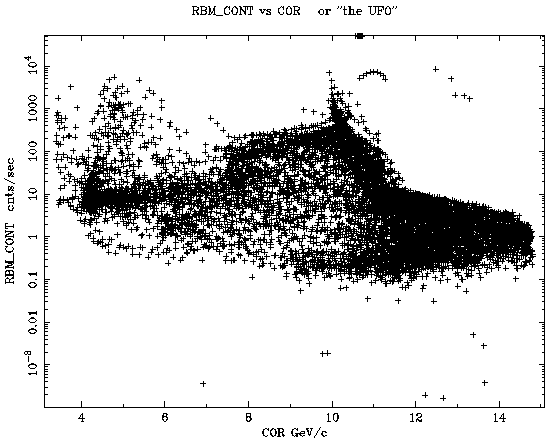The Dependence of SIS background on RBM_CONT
What is RBM_CONT?
In his study of dark Earth data, Keith Gendreau of the SIS team has found that the SIS internal background depends on the mkf parameter RBM_CONT (the radiation belt monitor count rate).Currently, we use COR (Cut-Off Rigidity) in our default screening. This is a geometric parameter which predicts the actual particle background well. RBM_CONT, on the other hand, is an in-situ measurement: during SAA passages, RBM_CONT values can be above 10000 cps. Outside SAA, RBM_CONT averages near 1 cps at COR=14 GeV/c and 10 cps at COR=4 GeV/c, with frequent episodes of RBM_CONT in the 100-5000 cps range at COR < 6 GeV/c. Even excluding the SAA passages, however, there are persistent occurances of moderately high (~several hundred cps) RBM_CONT when COR is in the 7-11 GeV/c range (see the plot below).

SIS dark Earth data collected with the conditions COR > 6 (default) and RBM_CONT > 50 (currently not used in default selection) show enhanced detector background, particularly in the Al K-alpha line at 1.49 keV (NB normally this line is undetectable due to cosmic X-ray background). We intend to carry out further studies after which we will determine whether to keep the default screening as is, replace with an RBM_CONT criterion, or use a combination. Such a combination may be found to optimally select the data.
RBM_CONT and your data
In the meantime, GOs can investigate how the count rate of their data depends on RBM_CONT and COR by using the "mkfbin" and "plot mkf" commands in XSELECT (see example below). This is especially recommended for GOs interested in weak features around 1.5 keV. GOs can screen their data based on RBM_CONT by using the "select mkf" command in XSELECT manually or using the "-q" option of ascascreen. With this option, ascascreen will produce three files: <name> .xco, <name> _obscat.sel and <name> _mkf.sel (where <name> is the output file name you entered). Edit the <name> _mkf.sel file and add something like&& RBM_CONT < 100
(and optionally remove "&& COR>6"). Then type "xselect <name> ".
Example Plotting RBM_CONT, COR and SAA
test-ASCA-SIS0-BRIGHT > mkfbin > Enter list of mkf parameters to bin >[BR_EARTH S0_PIXL1] SAA COR RBM_CONT > Give print-out time interval >[32] 32 test-ASCA-SIS0-BRIGHT > plot mkf The available parameters are: ---------------------------- 0 - TIME 1 - SAA 2 - COR 3 - RBM_CONT > Enter independent variable ( 0 for TIME ) >[0] 0 > Enter dependent variables (e.g. 1-6) >[1-3] 1-3 PLT> win 4 PLT> log y PLT> r y 0.1 1e5[In plot mkf, n-th quantity is plotted in "window n+1" (in this case, RBM_CONT is plotted in "window 4"). RBM_CONT panel is useless unless you change the y scale to logarithmic; 0.1 and 100000 are good lower and upper limits.]
If you have any questions concerning ASCA, visit our Feedback form.

